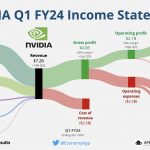
Global Economic Outlook: A Comprehensive Analysis of Q2 Predictions and Trends
- Non-Equity Fady
- April 19, 2023
- Economy
- 2 columns posts, 2023, economy, FORECASTS, inflation, Q2
- 0 Comments
As we enter the second quarter of 2023, it is crucial for businesses and investors to understand the global economic landscape and the factors driving growth and change. This article provides an in-depth analysis of the key trends and predictions for the global economy in Q2 2023. We will examine the significant indicators, regional outlooks, and potential risks that may impact the global financial market.
Major Economic Indicators
Gross Domestic Product (GDP) Growth: Following a period of economic recovery, the International Monetary Fund (IMF) projects global GDP growth to be around 4% in 2023. Advanced economies are expected to maintain a steady growth rate, while emerging markets are predicted to experience faster expansion due to increased investments and fiscal stimulus measures.
Inflation: Inflation rates continue to be a concern for policymakers and investors alike. Central banks are closely monitoring inflation levels to determine the appropriate policy measures to maintain price stability and support economic growth. The global average inflation rate is anticipated to remain within the target range, but regional variations are expected.
Employment: The global unemployment rate is gradually decreasing, thanks to the recovery of various sectors impacted by the pandemic. However, job creation remains a top priority for governments worldwide, as they aim to provide employment opportunities and stimulate economic growth.
Key Regional Outlooks
United States: With a strong economic recovery, the U.S. Federal Reserve is expected to continue its gradual tapering of bond purchases, ultimately leading to an increase in interest rates. The U.S. economy is projected to maintain steady growth, fueled by robust consumer spending and a solid labor market.
European Union: The European Central Bank (ECB) has signaled its intention to maintain a supportive monetary policy, keeping interest rates low to promote investment and growth. The EU’s focus on green initiatives and digital transformation is expected to drive economic expansion in the region.
Asia-Pacific: The Asia-Pacific region is forecasted to experience robust growth in Q2 2023, driven by strong domestic demand, increased manufacturing activity, and a rebound in global trade. China’s economy is predicted to continue expanding, while India is poised to experience significant growth due to economic reforms and a young, expanding workforce.
Potential Risks and Uncertainties
Geopolitical Tensions: Ongoing geopolitical conflicts and tensions may impact global trade and supply chains, potentially hampering economic growth in affected regions.
Pandemic Developments: The evolution of the COVID-19 pandemic remains a wildcard factor for the global economy. Any resurgence or emergence of new variants could lead to renewed restrictions and slow down economic recovery.
Climate Change: The increasing frequency of natural disasters and extreme weather events due to climate change can disrupt global supply chains and negatively impact economic growth.
As we navigate through Q2 2023, it is crucial to keep an eye on these economic indicators, regional outlooks, and potential risks. Businesses and investors must be prepared to adapt to the ever-changing global landscape and make informed decisions to secure their financial future.



